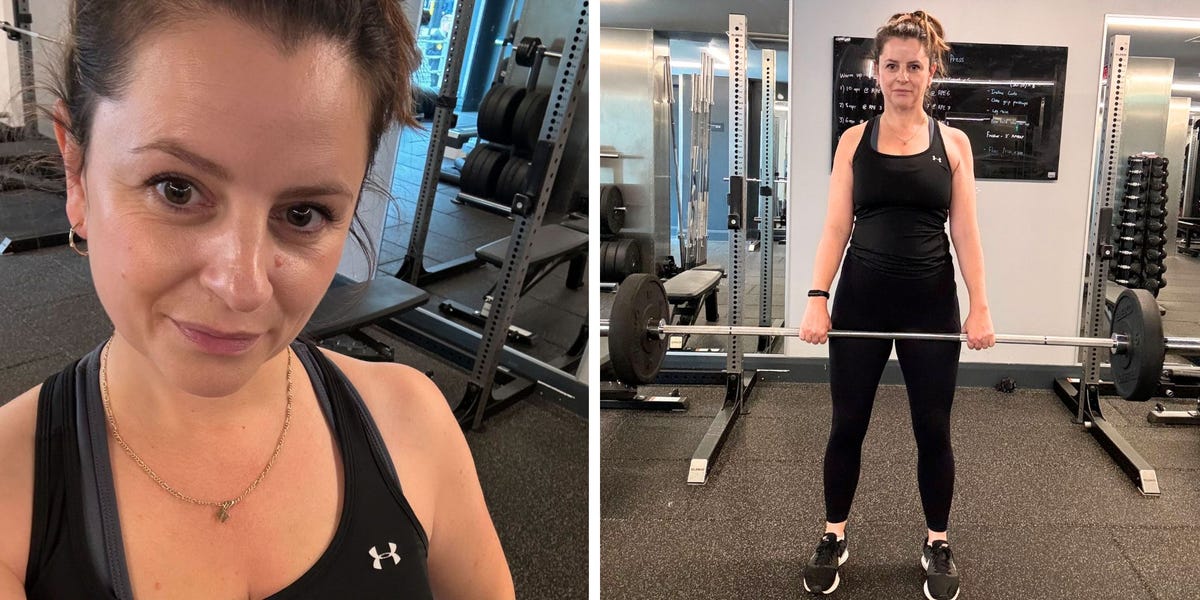Fitness
‘At 36, I started weight training again after three years off — here’s what I’ve learned’

There’s a reason why Jo Whiley’s Women’s Health cover has got people talking this month. Not only is the radio DJ looking seriously strong, but the fact that she’s built this body at the age of 59 has got tongues wagging.
In her cover interview, she told WH that while she likes to swim for cardio, what she loves most is doing weights in the gym. Clearly, her routine is paying off.
So WH hit up Jo’s personal trainer, Adam Davis, for a three-week training plan of Jo’s most-loved moves exclusively for Women’s Health members, focusing on building functional strength that makes you strong for real life.
The plan comprises three workouts a week, including a push workout, a pull workout and a leg session. Each of these is broken down into three supersets of one or two killer moves, which you do for a specified number of reps.
As someone who desperately needed to get themselves reacquainted with the free weights section of their gym, I decided to give it a go and see if I could build some real strength. This is how it went, and what I learned along the way…
THE PLAN
Week 1: Push, Pull, Legs
Week 2: Push, Pull, Legs
Week 3: Glutes, Push/Pull, Full Body
Week 1
A little context for you, I haven’t really been able to do much exercise since having my first baby back in 2021. A series of postpartum complications left me unable to do much except walking, yoga and Pilates – all great for staying active, but a far cry from the hardcore training of HIIT and boxing I was doing pre-kids. Plus, my experience of lugging a toddler around has taught me the importance of strength training to make fitness functional.
Last year, a study from University of San Diego found that muscle mass drops on average 23% during lactation. Granted this was a study on rats rather than humans, but considering I’m still breastfeeding and I’m weaker than a Love Island pick-up line, I can well believe this translates.
Thankfully, these first three sessions in the plan were a pleasant surprise – hard enough to feel challenged but not so tough I feft demoralised. I definitely felt the effects afterwards (hello, DOMS) but I finished the week high on a wave of confidence.
Week 2
I’m pleased to find there’s not much repetition of movements this week, which is important for keeping Jo committed, according to Adam: ‘Jo does enjoy the gym, but she likes having a variety of different movements to keep things interesting and not get bored.’
I find it more challenging this week though – the barbell tricep extensions from the push section almost broke me. The only bars I could get my hands on were 15kg in weight, so I struggled to get through one set, let alone four. So, I substituted the barbell for a dumbbell, and performed the remaining sets and reps of tricep extensions with that instead.
‘It’s a tricky exercise to do,’ Adam reassures me, telling me that while reducing the weight is the first thing to do, the next is to reassess form and mobility. I’m surprised that, what seems on paper, to be quite a simple plan could highlight so many things for me to work on going forwards. It’s definitely given me food for thought about what I should be focusing on when I work out, like making time to improve my mobility so that I can properly perform some of those more challenging upper body moves.
Week 3
Three weeks might not be long enough to truly see results in terms of building strength, but what I would say I’ve noticed is that my confidence in the free weights section of the gym has certainly improved. Between us, barbells always used to scare me a bit, but being forced to put on my big-girl pants and use them in order to follow a programme has helped me get more comfortable.
What I’ve actually enjoyed most is following a structured programme. The sense of achievement you get from completing each workout in the plan appeals to my inner overachiever, while not having to think about what I need to be doing in the gym that day is not to be underestimated – something I reckon a lot of mothers can relate to. As a working mum-of-two, anything which can reduce my mental load gets a big thumbs up from me.
3 things I learned from following Jo Whiley’s plan
1. Jo Whiley is *crazy* strong
After being out of action for so long while I was pregnant and postpartum, I knew that I needed to build my strength back up, stat. Granted lifting has never been my MO, but I always did some kind of strength training each week so I was shocked by how weak I felt. Seeing my own pitiful state only served to make Jo Whiley’s super strong physique even more impressive.
Not only is she a mum of four, but she’s also turning 60 next year. Research shows that you lose 3-5% muscle mass each decade, but you’d never guess it by looking at Jo. ‘She’s strong, man!’ says Adam. ‘Especially when it comes to using her body weight. But her dedication is high. She loves to work out.’ The message? Consistency is key if you’re looking to build yourself a strong body.
2. Supersets are much harder than they look
Quick recap for you: supersets are where you group two separate exercises together, therefore cutting down on your rest time between sets. Sure, this make look simple on paper, but what this training plan taught me is that looks can be deceiving. Pairing dumbbell upright rows with reverse curls seemed not too challenging… until I got to my fourth round of ten reps of each, without the usual break time.
3. Lifting light doesn’t equate to easy
My toxic fitness trait is always thinking I can do the advanced level version of anything, even if I’ve never tried it before. If I’m in a class and the trainer offers a progression ‘for anyone after a challenge’, that’s like red rag to a bull for me. You’d think from the number of times I’ve failed miserably that I’d learn from my mistakes, but sadly, the message still hasn’t hit home.
So obviously I went far too big with my weights in week one, thinking I could easily bash out 4 x 10 reps despite not having lifted for a year since having my second child. Reader, I was humbled. Soon realising the error of my ways, I lightened my load, but a nagging voice in my head was questioning whether I’d really see any benefits with smaller weights. But Adam reassures me the high number of repetitions in the plan means you’ll still get those gains – lower weight but high reps is just more accessible for most people, and is a proven way to promote hypertrophy (i.e. muscle growth).
What to do next?
Now that I’ve completed the plan, I asked Adam what I should be thinking of doing next in terms of training. ‘It depends on what your goals are,’ he tells me, ‘But you can absolutely recycle the plan again. For example, if you’re looking to increase strength, an easy swap would be increasing the weight and reducing the reps. When you’re tweaking it, you need to think about progressive overload, so either adding more reps or more weight, or reducing rest time between the sets. Making it slightly more challenging each time, that’s what your body responds to.’
So I’m starting it all over again on Monday, but just upping the weights slightly. Why not join me and let me know how you’re getting on? I’d love to hear from you @womenshealthuk.
Read now: How to practise self-compassion and become more confident
More fitness stories:
Cut through the noise and get practical, expert advice, home workouts, easy nutrition and more direct to your inbox. Sign up to the WOMEN’S HEALTH NEWSLETTER

Georgie Lane-Godfrey (she/her) is our Features Director, working across those fascinating longer reads you find in Women’s Health UK.
She also acts as Membership Content Editor, overseeing everything that appears on the Women’s Health Collective website, and in its weekly newsletter, The Dispatch.
With over ten years experience in women’s lifestyle journalism, Georgie has worked for titles such as Stylist, Glamour, Evening Standard and Marie Claire.
When she’s not at work, you’ll most likely find her either walking her rescue lurcher on Wimbledon Common or reading, as she’s currently undertaking an MA in Renaissance Studies.











